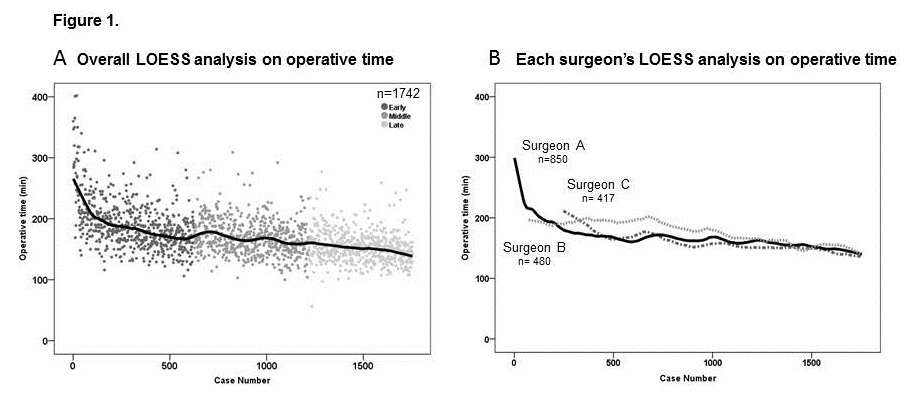When Does the Learning Curve End? A High-Volume Single Center Experience with Laparoscopic Donor Nephrectomy Over 16 Years.
1Division of Transplant Surgery, Department of Surgery, University of California San Francisco, San Francisco, CA
2Department of General Surgery, Japanese Red Cross Kumamoto Hospital, Kumamoto, Japan
3Department of Renal Transplant Surgery, Aichi Medical University School of Medicine, Nagakute, Aichi, Japan
4Department of Transplant Surgery, UMass Memorial Medical Center, Worcester, MA
Meeting: 2017 American Transplant Congress
Abstract number: 473
Keywords: Donation, Kidney transplantation, Outcome, Survival
Session Information
Session Name: Concurrent Session: Surgical Issues (Minimally Invasive/Open): All Organs
Session Type: Concurrent Session
Date: Tuesday, May 2, 2017
Session Time: 2:30pm-4:00pm
 Presentation Time: 3:42pm-3:54pm
Presentation Time: 3:42pm-3:54pm
Location: E451a
Purpose: No studies for any type of surgery have examined learning curves beyond a decade or 100 cases because surgeon turnover and lack of complete records have precluded long-term analysis. We hypothesized that the learning curve for laparoscopic donor nephrectomy (LDN) would extend well beyond over 100 cases.
Materials and Methods: We retrospectively analyzed the records of 1742 LDNs from 1999 to 2015 in our institution. Three surgeons performed pure intra-peritoneal LDN. Donors were divided into three groups (early: 1999-2005, middle: 2006-2010 and late: 2011-2015) and outcomes of donors and recipients were analyzed with a specific focus on the learning curve using LOESS (locally weighted scatter-plot smoothing) regression analysis.
Results: The complexity of cases increased over time as experience grew. However, outcomes including operative time and surgical complications significantly decreased over each 5y period (operative time: 192.1±42.7 vs 170±28.6 vs 153.6±26.0 min, p<0.001; surgical complications: 11.5% vs 8.8% vs 4.7%, p<0.001). The learning curve was steep for the first 100 cases, but has not plateaued even after 15 years, despite the lack of major changes in technique over the last decade. Each surgeon's learning curve followed the same general trend, although each surgeon operated independently of the others (figure1). Recipient outcomes in the late group have improved including the reductions of slow graft function in 36% (p=0.002) and serum creatinine in 11% (1w p=0.02, 3y p=0.002) compared to the early group.
Recipient outcomes in the late group have improved including the reductions of slow graft function in 36% (p=0.002) and serum creatinine in 11% (1w p=0.02, 3y p=0.002) compared to the early group.
Conclusion: The learning curve for LDN extends well beyond the 100th case mark, with ongoing improvements of already excellent outcomes beyond 10 years.
CITATION INFORMATION: Yamanaga S, Posselt A, Freise C, Niemann C, Rosario A, Fernandez D, Kobayashi T, Ahearn A, Tavakol M, Kang S.-M. When Does the Learning Curve End? A High-Volume Single Center Experience with Laparoscopic Donor Nephrectomy Over 16 Years. Am J Transplant. 2017;17 (suppl 3).
To cite this abstract in AMA style:
Yamanaga S, Posselt A, Freise C, Niemann C, Rosario A, Fernandez D, Kobayashi T, Ahearn A, Tavakol M, Kang S-M. When Does the Learning Curve End? A High-Volume Single Center Experience with Laparoscopic Donor Nephrectomy Over 16 Years. [abstract]. Am J Transplant. 2017; 17 (suppl 3). https://atcmeetingabstracts.com/abstract/when-does-the-learning-curve-end-a-high-volume-single-center-experience-with-laparoscopic-donor-nephrectomy-over-16-years/. Accessed December 24, 2025.« Back to 2017 American Transplant Congress
